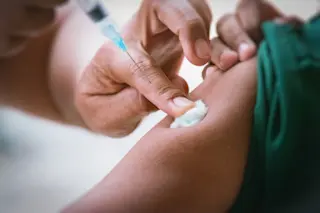Ngurah Rai International Airport in Bali is best known as a tourist hub, the bustling port of entry to a volcanic paradise. But when Indonesian authorities learned that a Mexican swine flu had gone global, that hub became a surreal microcosm of flu politics. Each arriving passenger was scanned for fever. A Dutch woman, apparently ill while in flight, was greeted by health workers in hazmat suits and whisked into quarantine while fellow passengers were spritzed with disinfectant. The woman was found to have nothing more than a bad sore throat, according to news reports, but that did not change a thing. The controversial head of the Indonesian Health Ministry, physician Siti Supari, quarantined sick foreigners at warp speed. Already embroiled in a battle royal with the world’s superpowers over another flu virus—the ultra-lethal bird flu—Supari did not have time to deal with a new enemy. She would do everything possible, she told her fellow citizens, to protect them from the new pathogen spawned by a pig.
The recent frenzy in Bali stood in notable contrast to the research paralysis that has gripped this tropical archipelago since late 2006, when Supari declared that flu viruses circulating in Indonesia belonged to her government alone. It was a bizarre, 21st-century twist on an age-old intellectual property argument. Developing nations had long fought passionately over plant and native human genes, but no one had ever before staked claim to microbes that birds could carry anywhere. Yet the 57-year-old health minister insisted she had cause: Rich Western nations were patenting the viral genomes, then using the information to create vaccines that were sold for profit to other Western powers while benefiting Indonesia not at all.
If Supari had stopped there, she might have garnered real support. But she ramped up the rhetoric, launching a barrage of fear bombs by accusing the United States of genetically engineering H1N1 (the swine flu virus) and H5N1 (the bird flu pathogen) as biological weapons. Wielding those charges, she flouted agreements with the World Health Organization (WHO), refusing to share samples from Indonesians infected with avian influenza—specimens the rest of the world desperately needs to track a virus on the move.
Supari not only has clamped down on viral and epidemiological information but has also cut off cooperation with NAMRU-2, the U.S. Naval Medical Research Unit in Indonesia’s capital city, Jakarta. Since 1970 the lab has helped advance knowledge on a range of infectious diseases, including malaria, dengue, and, more recently, bird flu in Southeast Asia. But Supari wants the Americans and their scientific paraphernalia to get out.
This standoff has escalated into a full-blown geopolitical dispute over influenza viruses. Negotiations are so delicate that talks on the U.S. end have risen to the highest levels of diplomacy. The State Department would neither confirm nor deny that Secretary of State Hillary Clinton’s visit to Indonesia in February had something to do with NAMRU-2. “We have no comment on the secretary’s private conversations,” said a source who requested anonymity. Despite intermittent signs of a thaw, this past May Supari reportedly threatened with severe punishment any Indonesian scientist caught conducting experiments with researchers at the naval laboratory. Once bustling with scientists, that lab now has only a handful of researchers, all on temporary visas.
Supari could be written off as an inconsequential hothead if not for the spread of bird flu in Indonesia and the looming international threat it presents. Global health leaders need her cooperation to trace a virus that is relatively rare in most of the world but that has left few regions in this chain of 17,500 islands unscathed. That virus may still represent one of the world’s greatest public-health threats, some scientists fear.
Their concern is based on several chilling facts. More people—and more birds—have died of avian influenza in Indonesia than anywhere else on earth. Smoldering in rural regions as well as cities, the H5N1 virus has the potential to kindle a pandemic strain. With a new, easily transmissible swine flu already circling the globe, scientists are understandably nervous. Some are talking about the potential of a gene swap between the pig and avian flu strains. Long feared as a breeding ground for novel flu viruses—many variants of H5N1 have been identified in humans and chickens here—Indonesia is considered a likely spot where such a genetic reassortment event might occur.
The creation of a swine-avian hybrid could have nightmarish consequences. H1N1 is comparable in severity to seasonal flu, and it spreads just as easily; H5N1 doesn’t pass easily between humans, but it is more lethal. Were bird flu and swine flu to combine, the result might be a killer strain comparable to the 1918 pandemic virus. The Indonesian strategy for preventing this dread convergence—scanning for fevers and disinfecting foreigners at the airport—will not keep the different flu strains apart. But Supari’s information blackout might prevent us from recognizing a deadly H5N1/H1N1 hybrid until it is too late.
Bird flu takes flight
Avian flu in Indonesia first caught the world’s attention in 2004, when it wiped out 16.2 million birds in a bit over a year. The first human cases appeared in 2005, and since then the virus has coursed through the country with the stealth of a serial killer. In fact, most of what we know about the human version of the disease comes from Indonesia, where avian flu goes by the nickname AI.
Many hospitals in the country now have AI units to stanch the tide, and with good reason: Of the 141 human bird flu cases in Indonesia reported to the WHO, 115 people have died, a death rate of more than 80 percent. Put another way, bird flu in Indonesia is about 8,000 times as deadly as the swine flu virus now making the rounds, according to global health expert Laurie Garrett of the Council on Foreign Relations in New York City.
As frightening as these statistics seem, the figures are based on spotty reporting from Indonesia’s Health Ministry, which means the actual number of infections and deaths might be substantially higher. Through the first three quarters of 2009, Indonesia failed to report any flu cases at all, even though the Food and Agriculture Organization (a body of the United Nations that monitors avian influenza in birds) has found the infection to be deeply entrenched among fowl in 31 of the country’s 33 provinces and endemic in Java, Sumatra, and Bali.
From the country’s first encounter with H5N1, authorities have wondered whether it spread to humans only from birds, or whether it was being passed from human to human as well. “In some instances we have seen some very limited human-to-human transmission,” says infectious-diseases expert Keiji Fukuda, the WHO’s interim assistant director general for health security and environment and director of its global influenza program. “But these instances involve very intense contact, where a parent might be taking care of an infected child.”
Fukuda notes that avian flu has been just as severe and difficult to control in other affected countries, such as Egypt, where a spate of human cases this year has drawn international concern. But nearly half of all bird flu deaths in humans have occurred in Indonesia, the world’s fourth most populous nation. Birds are of supreme economic importance and national pride here, status symbols kept as pets for their beautiful feathers or their song. Culling them to stop the flu is no simple matter.
Indonesians have hidden their birds when government agents have come to kill sick chickens and domestic ducks, common conduits of H5N1 to humans. Fruits and vegetables are widely sold in open-air venues called wet markets, which are points of sale for infected poultry as well. Children and adults have contracted avian flu while shopping for groceries.
With the danger so clear, Indonesia has cooperated with international disease-control efforts—but only at times. In 2007, after negotiations with the WHO’s Intergovernmental Committee, Supari agreed to share samples. The release of specimens was intermittent at best. “That is not enough for a country that seems to be a natural bioreactor for influenza strains,” says Michael Greger, director of public health and animal agriculture at the Humane Society of the United States. “It is important to know what’s really going on there.”
Far more often, Indonesia has played the renegade, openly ignoring guidelines governing the WHO’s Global Influenza Surveillance Network, a 57-year-old system through which researchers gather and share samples from patients with flulike illnesses. About 128 laboratories in 99 countries, including Indonesia, are signatories; large national public-health laboratories in the United States, Great Britain, Australia, and Japan anchor the network.
Yet most Americans are barely aware of the political folderol that has been going on for years. Many view bird flu as a passé threat that rarely makes the news anymore and hope that swine flu will similarly fade from view. “When a pandemic didn’t happen the week after the bird flu stories broke, the stories were no longer interesting,” says Greger, who wrote the book Bird Flu: A Virus of Our Own Hatching. “For many people, bird flu is the story of the boy who cried wolf. And just like the story, not only is the wolf real, but it is still out there.”
Aria of the flu divaSiti Supari is as adept at getting under the collective skin of the world’s superpowers as she is at playing on the fear of Western science that runs through Indonesia’s population, which is predominantly Muslim. She knows how to gin up the rhetoric and rev up the crowds. Her jingoism often inflames activists, who can be found protesting outside the American embassy in Jakarta, trying to shout the remaining Americans out of town. But she did not start her professional life with a vision of standing on the global stage or adopting the multiple, competing public personas she has assumed: agent provocateur, warrior-defender of Indonesia, trash-talking drama queen.
In various snapshot biographies used as introductions before her speeches, Supari is said to hail from central Java, where she was born in 1949. From a young age she set her sights on a career as a physician, a goal she achieved after earning a medical degree from Gadjah Mada University in Yogyakarta. Neither influenza nor global public health was a part of her work. Throughout the 1980s Supari treated heart patients; she then went back to graduate school to obtain a second doctorate, in cardiology. An academic career consumed her time until 2004, when the newly elected president, Susilo Bambang Yudhoyono, appointed her to head Indonesia’s Health Ministry. Diminutive and bespectacled, with a penchant for poufy, retro hairstyles, Supari has a soft, high-pitched voice that contrasts sharply with the incendiary tone she adopted in her new position.
Supari’s press representatives in Jakarta declined repeated requests for an interview. However, Triyogo Jatmiko of Indonesia’s Permanent Mission to the United Nations in New York City provided a transcript of a Supari speech delivered to global health officials in Geneva, which helps illuminate her dramatic approach. In it she casts her country as resource poor, seeking a level playing field alongside the rich nations that are home base to Big Pharma.
“As a citizen of a developing country, I must keep voicing the need to explore the development of transparent, fair, and equitable virus sharing and benefits sharing,” she said. The “benefits,” she explained, are the vaccines, diagnostics, and other technologies developed from flu viruses and their genes. These products, she said, elude resource-poor countries such as her own because costs can be crippling.
In press reports and speeches, Supari says Indonesia has shared freely for decades and received nothing for its cooperation. In a book entitled It’s Time for the World to Change, published last year, she charges the United States and the WHO with conspiring to use H5N1 as a biological weapon against Indonesia and other poor countries. In March she reportedly announced that she wanted to stop vaccinating children against meningitis, mumps, and other childhood diseases with Western-made vaccines. The Associated Press quoted her as saying she did not want global pharmaceutical companies exploiting Indonesians the way they have exploited Africans. Supari further accuses the West of harboring plans to profit from third world misery by selling frightened, flu-affected nations expensive vaccines. Her willingness to speak out loudly against Western companies and governments has upped the wattage of her star power in Indonesia.
“She’s a national heroine. They love her and treat her like a rock star,” says Sharon Sanders, editor in chief of FluTrackers, a nonprofit Web site headquartered in Winter Park, Florida. The site sponsors discussions about all forms of influenza, and Indonesia’s reluctance to abide by international agreements is a frequent topic of concern. Many bloggers are outraged that a manipulative, second-tier official from a developing nation can hold the rest of the world by the throat. “It is apparent that many Indonesians don’t trust the U.S. government,” Sanders says.
Scientists who have dealt with Supari see her as a crafty negotiator capable of bargaining successfully with the strongest nations on earth. The key tenet in her intellectual property argument—that viruses infecting Indonesians belong to Indonesia —extends beyond pathogens that cause the flu. She doesn’t want Western scientists to study blood samples from any Indonesian for any reason, at least not until she gets something valuable in return.
“Minister Supari is a smart lady because most of this is about leverage,” says Anthony Gaspari, chairman of dermatology at the University of Maryland in Baltimore. Gaspari has been studying an exceptionally rare disorder affecting a 37-year-old Indonesian man named Dede. “What she’s saying is ‘We have something that is very desirable, but we are not giving it to you unless we get a cut of the action.’?”
Supari and her Health Ministry have barred shipments of blood samples from Dede, who is known as Tree Man. His unusual response to the human papilloma virus—HPV—caused him to develop thick, barklike warts all over his body, giving him the appearance of a man in a tree suit, minus the leaves.
“It’s not just the bird flu virus, it’s across the board. She’s not allowing any samples out of the country,” says an exasperated Gaspari, who consulted with the Indonesian surgeons who removed some of the warts and obtained a sample of Dede’s blood when he traveled to Indonesia in June 2007. Supari later accused him of taking the samples to make vaccines without her permission, Gaspari reports. He returned to Indonesia in March 2008, and this time Supari blocked him from taking samples home. “With a condition so rare, there’s no money in it for Big Pharma. The research would benefit only Dede,” Gaspari says.
Who owns the flu? Biological material as intellectual property is a hot-button issue with a long and storied past. A famous legal case decided in 1990 by the high court of California introduced the public to what seemed a startling notion at the time: Biological material not only can be patented but, like computer chips or other commodities, can be worth tremendous sums.
The California case involved a patient by the name of John Moore, who was diagnosed with hairy cell leukemia in 1976. His physician, David Golde of UCLA, found a rare T lymphocyte in Moore’s blood that could be coaxed into making an immune-boosting protein. Golde had a name for Moore’s samples: Mo cells. The discovery helped pave the way for a multibillion-dollar business of making drugs to pump up the immune system in chemotherapy-ravaged cancer patients.
For years Moore was not told that his cells had been used in the research, even though he was curious why he had to travel so often to Los Angeles and why he was always asked to provide blood. Seven years after Moore’s initial therapy, Golde asked his patient to sign a contract relinquishing his rights and those of his heirs to any cell lines or products derived from his blood or tissues (Moore’s spleen had been removed in the course of his treatment). It was only then that Moore became aware of the fortune coursing through his blood.
The California court agreed that Moore’s informed consent should have been obtained and that Golde had violated doctor-patient trust. However, it ruled that the patient had no property rights to his own cells. As far as Supari is concerned, John Moore and Indonesia have been victimized in similar ways.
Other recent cases bolster her argument. In 2005 Australia’s WHO-affiliated laboratory obtained a specimen from an Indonesian bird flu patient and shared it with CSL, an Australian drugmaker. CSL used genetic sequences from the sample to develop a bird flu vaccine. Then the sample made its way to the Centers for Disease Control and Prevention (CDC) in Atlanta, which also developed a vaccine. Physician Rachel David, a CSL spokeswoman, says the Australian vaccine is part of her country’s cache of supplies to protect its population in the event of an avian influenza outbreak. “The product is licensed and stockpiled in Australia,” she states, and is, at this point, available only for Australians.
In the United States, meanwhile, the genes were used to develop an innovative DNA vaccine. DNA flu vaccines effectively stimulate an immune response, much as traditional vaccines do. Unlike the older drugs, however, they do not involve antiquated steps, such as growing live flu viruses in fresh, fertilized hens’ eggs and then inactivating the virus. Instead, genetically engineered DNA in the vaccine coaxes the body to produce H5N1 antibodies, providing immunity. This technique could be more easily ramped up in the event of a pandemic, experts say.
A patent application for the DNA vaccine was filed with the U.S. patent office by the CDC and the National Institutes of Health in early 2006 and with the World Intellectual Property Organization some 18 months later. As this goes to press, there is one FDA-approved vaccine for H5N1 in the United States, stockpiled by the government but not for sale.
New York University School of Law fellow Matthew Herder has been studying the impasse between Indonesia and the rest
of the world since it began nearly three years ago, and he suggests a way to prevent similar disputes in the future: Developed countries should provide technology transfer to help poor countries, allowing them to produce their own vaccines. NAMRU-2 could have been a site for such instruction, but its sour relationship with the Indonesian government makes the possibility unlikely—unless, of course, a deal can be struck.
Fukuda of the WHO has been involved in talks to broker that deal. He sees strength in some of the Indonesian claims. “From my perspective and from listening to the minister from Indonesia talk on this issue a number of times, I think the one point that the Indonesian government has made over and over—and the main reason they are holding back—is that they regard the whole system as to how viruses get turned into vaccines unfair,” he says. The issue is not about intellectual property per se, in Fukuda’s view, but about sharing benefits derived from the viral material that a country provides.
Supari’s stance trains a spotlight on tenets in the Convention on Biological Diversity, an international agreement hammered out in Rio de Janeiro in 1992. The initiative provides protection under international law for genetic resources within a country’s borders. It was created in part because poor nations were feeling pushed around by wealthy ones.
“Countries were saying, ‘You’re coming here taking our stuff and we’re not getting anything in return,’?” says Richard Gold, a professor of law at McGill University in Montreal, referring to the state of affairs that led to the Rio pact. The initiative also promotes “fair and equitable sharing of genetic resources.”
Still, there are striking differences between the issues on the table in Brazil 17 years ago and the concerns involving Indonesia now. In 1992 countries were mostly focused on controlling the genes from indigenous plants. Viral genes are another story entirely, because they easily move with people across international borders, causing diseases thousands of miles away. The human impact of delaying access to flu genes is also much more stark.
Gold, who serves as president of the Innovation Partnership, a nonprofit devoted to smoothing impasses in intellectual property disputes, is not involved in the flu standoff, but he describes it as a classic case of poor versus rich. “I wouldn’t be so quick to condemn Indonesia,” he says, despite his disagreement with Supari’s stance. “If you have a population that is suffering from this virus and no one is giving you assurances that you will share in a vaccine, then you’ve got a problem. The whole stability of the country could be at risk. It’s not a negligible issue. What Indonesia is asking for is access to products that come out of biological materials they have shared, at a price they can afford.”
The new Cold War Will peace ever reign between Supari’s Health Ministry and the superpowers that control flu science? In December of last year the U.S. State Department hoped for a complete resolution of the dispute by 2009. But then the new swine flu strain began girdling the globe, forcing its avian cousin deeper into the recesses of public consciousness. And that was not the only change. A senior State Department official, who agreed to speak to DISCOVER on the condition that his name remain out of print, recently left the agency. Before his departure he had been cautiously optimistic: “If this is resolved by May, this would, I assume, solve the immediate concern of not receiving samples from Indonesia,” he said early in the process. But nearly a year later, it appears that no progress has been made. “We continue to discuss the future of NAMRU-2 with the Indonesian government,” says another U.S. government source. Some observers say that, rather than continuing to negotiate with the Indonesians, the American government might simply decide to establish an infectious-diseases lab elsewhere in Southeast Asia where the government is friendlier.
Yet the wide proliferation of H5N1 strains in Indonesia makes that approach risky. Not knowing precisely how H5N1 is mutating there leaves a frightening vacuum, especially with a second novel flu virus, the swine flu, circulating worldwide. Currently there is no evidence of a gene swap between H5N1 and H1N1, according to WHO officials, but the potential certainly exists. And questions abound, many from researchers and developers who say they need recent virus samples to produce more efficient vaccines.
“When viruses are unavailable for work in the lab, that is really a downside,” says Larry Smith, vice president of vaccine research at Vical Inc. in San Diego. Like scientists at the CDC, Vical has developed a DNA vaccine, this one based on an H5N1 strain from Vietnam. Unlike the CDC, Vical has already tested its vaccine in human volunteers throughout the United States. The Vical treatment has been shown to produce a potent immune response, a sign that DNA vaccines could offer powerful protection if H5N1 mutates into a pandemic strain. “We wanted to test our vaccine against H5N1 from Indonesia to see what the breadth of our antibody response would be against that strain,” Smith says. “The WHO was making a request on our behalf. We really can’t make those appeals ourselves.” Despite his company’s entreaties, the request has not been granted. Instead, Vical tested the vaccine against H5N1 strains from other countries.
Scientists in academia also are hoping for a breakthrough in combating flu viruses. In addition to studying samples, some researchers say they wish they could follow H5N1’s footprint, tracking how deeply it has become entrenched and monitoring the pervasiveness of outbreaks in wild and domestic birds. Most important, scientists want better information on how the virus is affecting people. “We don’t know what’s going on in Indonesia,” says Andrea Gambotto, a University of Pittsburgh vaccinologist who has also developed an innovative vaccine based on H5N1 genes from Vietnam.
Gambotto worries that the lack of fresh statistics poses a risk to everyone—including the people of Indonesia. “In Indonesia the epidemiology is poor, the surveillance is poor, and the mortality is worse than the virus that caused the pandemic in 1918. Anything we can find out would be helpful,” he says.
The Great Flu Conspiracy
Conspiracy theories abound during pandemics, and now, with the emergence of H1N1, the Internet is propelling the paranoia to new heights. (Google yields more than 2 million hits on the topic.) Yet no one has spun so intricate and technical a conspiratorial tale as Austrian blogger Jane Burgermeister.
Last summer, she lost her job as European correspondent for Renewable Energy World, an online publication, after filing charges with the F.B.I. against the World Health Organization, the United Nations, and several top U.S. government officials, claiming they are part of a plot to depopulate the United States using tainted H1N1 flu vaccines. Burgermeister has also filed charges against pharmaceutical giant Baxter Healthcare and AVIR Green Hills Biotechnology of Vienna. In 2008 samples of Baxter’s seasonal flu virus material supplied to AVIR contained traces of H5N1, the deadly bird flu strain. The problem was discovered after AVIR sent samples to several other European laboratories.
Baxter spokesman Christopher Bona said the samples were never meant for human or commercial use and blamed the incident on technical error. However, Burgermeister sees the error as intentional, part of a secret scheme to release engineered flu viruses so the companies can profit by selling vaccines. Her Web site, www.theflucase.com, is a mix of scientific-sounding warnings and political broadsides; it points to “evidence that an international corporate criminal syndicate, which has annexed high government office inside the United States, is intent on carrying out a mass genocide using an artificial (genetic) flu pandemic virus and a forced vaccination program.”
Why? “To transfer control of the United States to WHO, the U.N., and affiliated security forces,” Burgermeister asserts. Numerous flu conspiracy Web sites—spreading virally almost as quickly as the flu itself—now link to Burgermeister’s Web pages, but critics say these venues are spinning an old saw: the notion of scientist as evil genius, a soulless automaton pursuing money, power, or unsavory schemes.
It could be that the risk intrinsic to science has given the theories a foothold. Columbia University microbiologist Vincent Racaniello, who helped develop the first artificial virus in the 1980s, cites the stir created four years ago when nearly 5,000 labs seeking accreditation were mistakenly shipped vials of the 1957 pandemic flu strain as part of their test kits. Conspiracy theorists portray the scientists as literally planning and creating global disease, but Racaniello says, “That is way beyond what we can do.”
“Conspiracy theorists have always been around, and the Internet allows them to meet and have a greater voice,” says Paul Offit, director of the Vaccine Education Center at Children’s Hospital of Philadelphia. “A common thread in all the conspiracy theories is that the world is in grave danger. Reality is often less scary, and hence less interesting.”
Michael Shermer, executive director of the Skeptics Society, argues that conspiracy theories come from an ancient human tendency to stay on guard against predators. “Paranoia runs deep in the human psyche,” he says. D. R.















